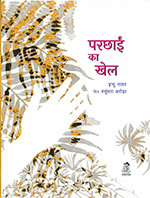Parchhai ka Khel is a simple read about a girl and her exploration of her shadow.
Once the girl explores her shadow, what follows is her various movements and changing shadows. Whatever the girl does, her shadow follows.
The book tries to explain the concept of shadow through a linear narrative. If a reader is someone who isn’t familiar with the concept, the book doesn’t give enough for the reader to really understand the same. It uses the word ‘parchhai’ plainly, in a matter-of-fact way, assuming the reader knows it. Simultaneously, the book does intend to introduce the concept as well but isn’t able to do that, in a lucid manner. It hurriedly comes to the concept rather than building it up through the story. In the first page itself, we are told:
‘लड़कीनेआसमानकीतरफदेखा।आसमानमेंसूरजचमकरहाथा।उसनेज़मीनपरदेखा।उसेअपनीपरछाईंिदखी।लड़कीनेआसपासदेखािकसबकीएकहीपरछाईंबनतीहै।’
What follow in the subsequent pages are the girl’s movements and her changing shadows. Her relationship with the shadow is central to the story but there isn’t enough depth or meaning given to this relationship. Just as the the story hurriedly reveals to us the existence of the phenomenon of shadow, it hurriedly gives away the fact about how sunlight/light are conducive to the phenomenon of shadow. The girl quickly understands one fine day when it rains, shadows do not appear.
‘आसमानमेंबादलिघरनेलगे… सूरजकोजबबादलोंकेढंकिदयातोपरछाईंगायबहोगई।उसरातलड़कीनेबन्दकमरेमेंटॉर्चकोअपनेहाथसेढंककरदेखा।दीवारपरउसकेहाथकीपरछाईंभीगायबहोगई।’
To observe, for a long time through scientific enquiry, is key to understanding complex phenomena or recognizing them. We humans spend days or at least a long time observing the world around us to conclude some natural happenings. But in this case, as pointed previously, the writer hurriedly ends the story thus making it a bit unrealistic on the part of a child to be so promptly observing and inferring the phenomenon.
The illustrations are less explanatory and more impressionistic; they don’t really help add further meaning to the text or help the reader understand the concept of shadow better. Some of the illustrations also come across as strangely ambiguous and terrifying.
This book serves as an introduction to the scientific concept of shadow. If only it had been done in a more engaging, fun way. It stops short of exploring shadows from a girl’s point of view, thus, lacking lustre and joy of playing with shadows. Going by the title Parchhai ka Khel, the book doesn’t give us enough ‘khel’, either play of narrative, language, or imagination.

